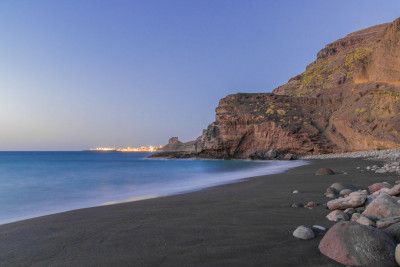Guayedra Beach

Guayedra, that wonderful beach where the green ravine of the same name ends. It is worth approaching on foot or by car and spending a day on one of the most beautiful wild beaches on this island, always guarded, yes, by the fantastic Roque Faneque, one of the highest cliffs in the world, and by Tamadaba Natural Park. If you don't connect with yourself here, it will be hard for you to find another more wonderful place.Guayedra beach is a nudist beach and is one of the wildest and most beautiful beach in Gran Canaria. It is very close to the town of Agaete and in fact the Puerto de las Nieves is seen in the distance…
Guayedra, that wonderful beach where the green ravine of the same name ends. It is worth approaching on foot or by car and spending a day on one of the most beautiful wild beaches on this island, always guarded, yes, by the fantastic Roque Faneque, one of the highest cliffs in the world, and by Tamadaba Natural Park. If you don't connect with yourself here, it will be hard for you to find another more wonderful place.Guayedra beach is a nudist beach and is one of the wildest and most beautiful beach in Gran Canaria. It is very close to the town of Agaete and in fact the Puerto de las Nieves is seen in the distance… The spot could not be more magical, as it is surrounded by palm trees and other vegetation, volcanic rocks, spectacular cliffs and Teide always facing you. The sunsets on this beach are unforgettable and one sunset is never the same here.
The real beach of Guayedra is the one that is located past the palm grove of the ravine of Guayedra. If you arrive by car, the path leaves you in what many already confuse as the beach of Guayedra and although you can also enjoy that one , there is no sand on that beach and access to water is difficult. You must continue the path until you pass the palm grove and then you access Guayedra beach, with sand almost all year round, except for the moments of high tide and some other moments which depend on the moon phases. Once there you will see some small fortifications built with volcanic stones to protect from the wind and have some privacy.
It is necessary to be very careful. Being a wild beach, there is no surveillance and there are only a couple of life buoys. The tides and currents on this beach should be taken seriously. It is the Atlantic Ocean, so it is better not to go too far into the sea and it is better to control when the tide begins to rise. It is not about being afraid but respect… There are days when the sea is really calm and without waves when Guayedra gives you authentic relaxing and paradisiacal baths.
Guayedra is the authentic aboriginal name that not only names the beach but the territory between the Lomo del Manco and the Lomo del Faneque. After the conquest of the island, the colonists ceded this territory to Fernando de Guanarteme (renamed after being arrested and who was the maximum leader or "Guanarteme" of the aboriginal town of Galdar before the conquest). Fernando de Guanarteme asked the Spanish Crown to borrow him the territory of Guayedra to be able to live with the few aboriginal survivors who survived the conquest in exchange for achieving the surrender of the indigenous resistance. In eight years the population in Guayedra increased from 80 to 150 inhabitants and fearful of the possibility that the Canarian population would rise up against the Crown, the Castilians decided to end this indigenous redoubt.
Guayedra can be reached on foot (approximately 1 hour) or by car (15 minutes by car and 15 minutes on foot).

